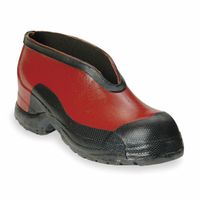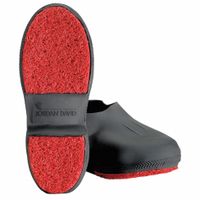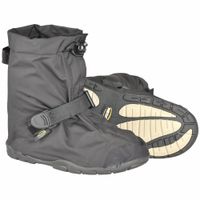Call +(254) 703 030 000 / 751 483 999 / 721 704 777
- Home
- Safety
- Footwear Footwear Accessories
- Overboots Overshoes
.....Read More
Frequently Asked Questions
What are overboots and overshoes used for?
Overboots and overshoes are protective footwear designed to be worn over regular shoes or boots. They serve several purposes:
1. **Protection from Weather Elements**: Overboots and overshoes provide a barrier against rain, snow, and mud, keeping the wearer's feet dry and warm. This is particularly useful in wet or snowy conditions where regular footwear might not offer sufficient protection.
2. **Safety in Hazardous Environments**: In industrial or construction settings, overshoes can protect against chemicals, oils, and other hazardous materials. They are often made from materials resistant to such substances, ensuring the safety of the wearer.
3. **Hygiene and Cleanliness**: In medical, laboratory, or food processing environments, overshoes help maintain hygiene by preventing the transfer of contaminants from shoes to clean areas. They are often used in sterile environments to ensure cleanliness.
4. **Durability and Longevity of Footwear**: By wearing overboots or overshoes, the underlying footwear is protected from wear and tear, extending its lifespan. This is particularly beneficial for expensive or specialized footwear.
5. **Traction and Stability**: Many overshoes are designed with enhanced grip and traction, reducing the risk of slipping on wet or icy surfaces. This feature is crucial for safety in slippery conditions.
6. **Convenience and Versatility**: Overboots and overshoes are easy to put on and take off, making them a convenient option for those who need to transition between indoor and outdoor environments frequently. They are versatile and can be used in various settings, from urban to rural.
Overall, overboots and overshoes are practical accessories that enhance the functionality and protection of regular footwear, catering to diverse needs across different environments and industries.
How do overboots and overshoes protect against chemicals?
Overboots and overshoes protect against chemicals by providing a barrier between the wearer's feet and hazardous substances. They are typically made from materials like rubber, PVC, or specialized polymers that are resistant to chemical penetration and degradation. These materials are selected for their ability to withstand exposure to specific chemicals, ensuring that the protective footwear remains intact and effective during use.
The design of overboots and overshoes often includes features such as seamless construction and reinforced areas to prevent leaks and tears, which could allow chemicals to reach the skin. The soles are usually slip-resistant and may be resistant to chemical corrosion, providing both safety and durability in environments where chemicals are present.
Additionally, overboots and overshoes are designed to be worn over regular footwear, creating an additional layer of protection. This layering helps to prevent direct contact with chemicals, reducing the risk of burns, irritation, or other injuries. The fit is typically adjustable to ensure a secure seal around the foot and ankle, further minimizing the risk of exposure.
In environments where chemical exposure is a risk, overboots and overshoes are often part of a comprehensive personal protective equipment (PPE) strategy. They are used in conjunction with other protective gear, such as gloves, suits, and masks, to provide full-body protection. Proper use, maintenance, and disposal of these protective items are crucial to ensure their effectiveness and to prevent contamination or accidental exposure.
Overall, overboots and overshoes are essential for protecting workers in industries such as chemical manufacturing, pharmaceuticals, and hazardous waste management, where exposure to harmful substances is a concern.
What are the benefits of safety toes and metatarsal guards in overshoes?
Safety toes and metatarsal guards in overshoes provide critical protection and numerous benefits for individuals working in hazardous environments.
Safety toes, typically made from steel, composite materials, or aluminum, shield the toes from heavy falling objects, compression, and punctures. This protection is crucial in industries like construction, manufacturing, and warehousing, where the risk of foot injuries from dropped tools or materials is high. Safety toes help prevent fractures, lacerations, and other serious injuries, ensuring workers can perform their duties without fear of debilitating accidents.
Metatarsal guards extend this protection to the upper foot, covering the metatarsal bones. These guards are essential for safeguarding against impacts and compression injuries that can occur when heavy objects fall or roll onto the foot. By distributing the force of an impact over a larger area, metatarsal guards reduce the risk of fractures and other injuries to the delicate bones in the upper foot.
Together, safety toes and metatarsal guards enhance workplace safety by minimizing the risk of foot injuries, which can lead to lost work time, medical expenses, and long-term disability. They also contribute to compliance with occupational safety regulations, which often mandate protective footwear in certain industries.
Additionally, overshoes with these features offer convenience and versatility. They can be worn over regular shoes, allowing workers to quickly adapt to different environments without changing footwear. This adaptability is particularly beneficial for workers who move between office and field settings.
In summary, safety toes and metatarsal guards in overshoes provide essential protection against foot injuries, promote compliance with safety standards, and offer practical benefits for workers in various industries.
How do traction devices in overshoes work?
Traction devices in overshoes work by enhancing grip and stability on slippery surfaces, such as ice or snow. These devices are typically made from durable materials like rubber, metal, or a combination of both, and are designed to be easily attached to the soles of shoes or boots.
The primary mechanism by which traction devices function is through the use of spikes, coils, or treads. Spikes, often made of metal, dig into ice or packed snow, providing a firm grip and preventing slips. Coils, usually crafted from stainless steel, create friction by biting into the surface, offering stability on icy paths. Treads, made from rubber or similar materials, increase surface area contact and channel away moisture, reducing the risk of slipping.
Traction devices are designed to be flexible and adaptable, allowing them to fit various shoe sizes and types. They are typically lightweight and compact, making them convenient to carry and easy to put on or take off as needed. Some models feature adjustable straps or elastic bands to ensure a secure fit, while others may use a slip-on design for quick application.
These devices are particularly useful for outdoor activities in winter conditions, such as walking, hiking, or running, where maintaining balance and preventing falls is crucial. By providing additional grip, traction devices help users navigate challenging terrains safely, reducing the risk of injuries associated with slips and falls.
Overall, traction devices in overshoes are an effective and practical solution for enhancing safety and mobility in icy or snowy environments, allowing individuals to maintain their active lifestyles even in adverse weather conditions.
What is the purpose of winter overboots and overshoes?
Winter overboots and overshoes are designed to provide additional protection and insulation for footwear during cold and wet conditions. Their primary purpose is to shield regular shoes or boots from snow, slush, ice, and moisture, thereby keeping the feet dry and warm. These protective coverings are typically made from waterproof materials like rubber, neoprene, or other synthetic compounds that prevent water penetration.
Overboots and overshoes also offer enhanced traction on slippery surfaces. Many models are equipped with textured soles or treads that improve grip on ice and snow, reducing the risk of slips and falls. This feature is particularly important in winter conditions where icy patches are common.
Additionally, they serve as a barrier against cold temperatures. By adding an extra layer of insulation, they help retain body heat, ensuring that the feet remain warm even in freezing weather. This is crucial for preventing frostbite and maintaining overall comfort during prolonged exposure to cold environments.
Winter overboots and overshoes are also convenient for preserving the condition of regular footwear. By covering shoes or boots, they protect them from the harsh elements, extending their lifespan and maintaining their appearance. This is especially beneficial for individuals who need to transition between indoor and outdoor settings frequently, as they can easily remove the overshoes upon entering a building.
In summary, the purpose of winter overboots and overshoes is to provide waterproofing, insulation, traction, and protection for regular footwear, ensuring comfort and safety in cold and wet winter conditions.
How do dielectric overshoes prevent static buildup?
Dielectric overshoes prevent static buildup primarily by providing electrical insulation and grounding. These overshoes are made from non-conductive materials, such as rubber or PVC, which do not allow the flow of electrical current. This insulation property is crucial in environments where static electricity can accumulate and pose a risk, such as in areas with flammable materials or sensitive electronic equipment.
The primary mechanism by which dielectric overshoes prevent static buildup is through their ability to dissipate static charges safely. When a person walks, friction between their footwear and the floor can generate static electricity. If this charge is not dissipated, it can accumulate on the body and discharge suddenly, potentially causing sparks. Dielectric overshoes help in two ways:
1. **Insulation**: The non-conductive material of the overshoes acts as a barrier, preventing the transfer of static electricity from the ground to the person wearing them. This reduces the risk of static charge accumulation on the body.
2. **Grounding**: Some dielectric overshoes are designed to work in conjunction with conductive flooring or grounding straps. They allow any static charge that does build up to be safely transferred to the ground, neutralizing the charge and preventing it from reaching levels that could cause a spark.
By combining these properties, dielectric overshoes effectively minimize the risk of static discharge, protecting both the wearer and the surrounding environment. This is particularly important in industries like electronics manufacturing, chemical processing, and other sectors where static discharge could lead to equipment damage, data loss, or even explosions.
What are anti-fatigue overshoes and how do they help?
Anti-fatigue overshoes are specialized footwear designed to be worn over regular shoes to provide additional comfort and support, particularly for individuals who spend extended periods standing or walking on hard surfaces. These overshoes are typically made from materials like rubber or polyurethane and incorporate features aimed at reducing fatigue and discomfort.
The primary function of anti-fatigue overshoes is to alleviate the strain on the feet, legs, and lower back by providing cushioning and shock absorption. They often include a thick, cushioned sole that helps distribute body weight more evenly, reducing pressure points and minimizing the impact on joints and muscles. This can lead to improved posture and reduced muscle strain, which are common issues for those who stand for long durations.
Additionally, anti-fatigue overshoes may have slip-resistant outsoles, enhancing safety by reducing the risk of slips and falls, especially in environments where floors may be wet or oily. This feature is particularly beneficial in workplaces like factories, kitchens, or hospitals.
By improving comfort and reducing fatigue, these overshoes can enhance productivity and overall well-being. Workers are less likely to experience discomfort-related distractions, allowing them to focus better on their tasks. Moreover, reducing physical strain can decrease the likelihood of developing chronic conditions related to prolonged standing, such as plantar fasciitis or varicose veins.
In summary, anti-fatigue overshoes are a practical solution for individuals who need extra support and comfort during long hours on their feet. They help by providing cushioning, improving weight distribution, enhancing safety, and ultimately contributing to better health and productivity.







